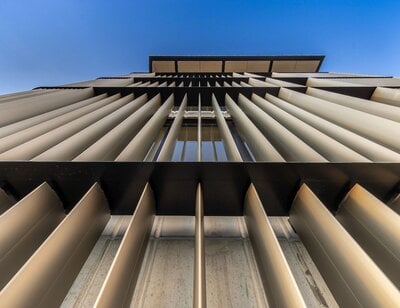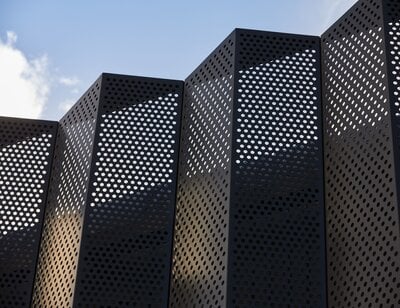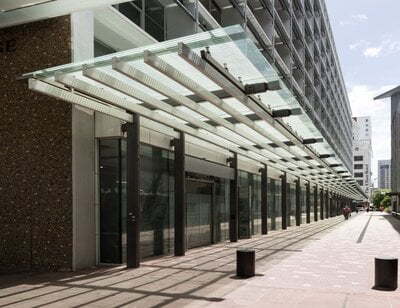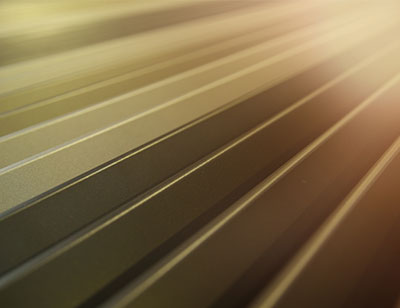Humankind has always poked holes in things. It’s done intentionally, unintentionally, metaphorically and physically. It’s also done to create some of the most appealing and original facades in architecture. But where did it all start exactly? We figured it might be fun to delve into the history of holes and find out. What follows is the complete history of perforated sheet metal. Well, the abridged version anyway…we’ll confess to there being some holes in it.
Etymology
Perforation is said to come from the Latin word perforatus, which is the past participle of perforare, meaning to ‘bore or pierce through’. First used around the early 15h century, perforare is a construct of per (through) and forare (to pierce). This makes sense. Although you have to wonder what words were used prior to the 15th century as perforation was certainly a thing before the word.
Perforation & Knights of the Realm
Cupules have perplexed scientists for generations. The world’s most common rock art, practised as far back as 9000 years ago, are thought to be used for everything from increasing the chances of rain to increasing the chances of conception. These purposeful and seemingly sequenced indentations in rocks can be found in Islamabad, Italy, Australia, and just about everywhere else. They might be considered the earliest form of perforated-like patterns although the perforations are incomplete, and they’re in rock, not metal.
Moving to ancient currency and we’re getting closer to what we consider to be perforated metal. Around 300 BCE, metal coins started to appear with holes in the middle. The general consensus was that the holes were there to make it easy to string the coins around your neck, which would make it harder to lose the newly minted valuables. Returning home from a hard day's work to explain to the family that this fancy new standardised currency is too easy to lose, would be a hard sell. Punching a hole in the coins to stop this happening was either great forethought or a quickly adopted adaptation from currency users. Unless…the reason for the holes is actually because it saved on valuable resources and made the coins less expensive to mint. Still, you’d think the first coin mint would have enough money to pay itself.
Jumping forward to around 800 AD and knights are roaming the land, jousting is a popular pastime and armies clash on horseback. Perforated metal is used in armour for protection. The holes, presumably too big to allow a sword or an arrow head through, were there to allow the knights to sweat a little easier. Possibly to shave a little weight too, so the poor horses carrying them could gallop a little easier.
Perforation and the Renaissance
Leonardo Da Vinci was a bit of a tinkerer, always scribbling down inventions for this and that. One of these scribbles was for an industrial rolling mill. For whatever reason, it was discarded and didn’t go anywhere, the public seemingly more keen to look at a small painting of a lady with an odd facial expression. 100 years later and the scribble resurfaces, with the first industrial rolling mill that produces sheet metal using elements from the design.
The rolling mill might not have the same historical significance or value as the Mona Lisa (which is valued at around $1 billion) but it certainly has much more use. The ability to produce uniform sheet metal has a direct impact on many other inventions. It’s used to hold architectural and structural components together, and finds its way into household appliances, aeroplane fuselages, automobiles and more.
This includes sieves. In Poland they were punching holes in metal to create sieves used in the making of cheese. More recently, in Japan during the Taisho Period, perforated metal sieves were used to help sort crushed stones.
Punching holes in metal didn’t really become a big thing until the late 1800s though. That’s when a chap by the name of Eli Hendrick decided punching holes in metal was a time-consuming and inaccurate endeavour when done by hand. So he invented a machine that could do it. There might have been holes in his products but there was none in his business planning. The company he founded in 1876 is still going strong today.
A Pattern Emerges
Simply making holes in sheet metal with the new machinery would be a little repetitive and boring. So companies started to get creative and experiment. What emerged from this period (early 1900s) are the wildly elaborate and ornate designs that would provide the character to many a New York building interior and exterior. They looked like something out of a F Scott Fitzgerald novel and are very much a part of the extravagance of the roaring twenties.
Over time, the patterns in perforated metal have become simpler yet also more complicated. They are simpler because designs are less ornate than those from the early part of the last century, but more complicated because of the ability to create life-like pictures. With computer modelling, holes of varying sizes and placement can be punched to create pictures for dramatic effect. For example, the custom dapple pattern at Windy Ridge School uses different open rates to create a changing depth and a scene that brings nature inside, closer to the students. Functionality (solar control) is there too. But it’s undoubtedly the aesthetics that take centre stage.
Modern perforated metal has become an art form and we’re able to create realistic images or abstract patterns. And if you want to get really adventurous, layering perforated patterns on top of each other to create a moire effect can introduce a truly beguiling aesthetic.
So where to go from here? What does the future for perforated metal look like?
Well…it looks very much like whatever you want it to look like.








